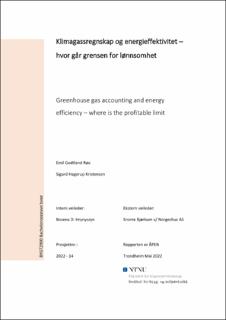| dc.contributor.advisor | Hrynyszyn, Bozena Dorota | |
| dc.contributor.advisor | Bjørkum, Snorre | |
| dc.contributor.author | Kristensen, Sigurd Hagerup | |
| dc.contributor.author | Røe, Emil Godtland | |
| dc.date.accessioned | 2022-06-29T17:19:22Z | |
| dc.date.available | 2022-06-29T17:19:22Z | |
| dc.date.issued | 2022 | |
| dc.identifier | no.ntnu:inspera:106805903:107035364 | |
| dc.identifier.uri | https://hdl.handle.net/11250/3001596 | |
| dc.description.abstract | Sommeren 2021 gikk Direktoratet for byggkvalitet, ut med et høringsforslag, som blant annet endringer i TEK17. En av endringene som foreslås, er at det skal komme krav om dokumentasjon av klimagassutslipp for noen prosjekter. På bakgrunn av dette, fremmet Norgeshus et ønske om å ligge i forkant av dette forslaget.
I denne oppgaven blir det utført klimagassregnskap, energisimuleringer og livskostnadsanalyser for tre bygg. Byggene baserer seg på et kataloghus fra Norgeshus, Dråpen Moderne. Referanseprosjektet er prosjektert for å oppfylle minstekravene i TEK17. Videre blir bygget omprosjektert til både massivtre- og passivhus. Byggenes resultater blir så sammenlignet og veiet opp mot hverandre. For å beregne klimagassregnskap benyttet gruppen seg av programvaren Reduzer. Dette er i skrivende stund ikke sluppet kommersielt, og gruppen har underveis i prosjektet tatt del i utvikling og utprøving av programmet. Energiberegningene for standard- og massivtrehuset ble gjennomført i SIMIEN, mens energisimuleringer for passivhuset ble utført parallelt i en annen bacheloroppgave (1). Kostnader over en periode på 60 år ble analysert gjennom livssykluskostnader for alle bygg.
Massivtrehuset viste seg å ha det laveste klimagassutslippet gjennom byggets levetid. Dette er på grunn av færre produkter og synlige overflater. Passivhuset fikk noe høyere utslipp enn standardhuset, selv om utslippene knyttet til ekstra tekniske installasjoner på passivhuset ikke ble medregnet. I et livsløpsperspektiv kom standardhuset best ut økonomisk. Det var forventet at passivhuset skulle komme best ut på grunn av kostnadsbesparelsen av energi over 60 år sammenlignet med de ander byggene. Det viste seg at ekstrakostnadene knyttet til de tekniske anleggene for passivhuset utgjorde en større sum enn besparelsen av energi.
Basert på resultatene vil standardhuset være den best investeringen, dersom livsløpskostnader veier tyngst. Hvis klimagassutslipp og innemiljø veier tyngst, er massivtre det beste alternativet. | |
| dc.description.abstract | Early summer 2021, the Norwegian Directorate of building quality presented a proposal of potential changes to “Byggteknisk forskrift”. One of the proposed changes is that there will be requirements for documentation of greenhouse gas emission for some projects. Norgeshus AS desired to be ahead of this proposal.
In this thesis, greenhouse gas accounting, energy simulations and life cycle cost analysis will be performed on three different buildings. These three buildings are based on a catalog house from Norgeshus. The catalogue house is designed to meet the requirements of TEK17. Furthermore, the building was redesigned to both solid wood and passive houses. The buildings’ results were then analyzed and compared to each other.
To calculate greenhouse gas emissions, the group decided to try the new software, Reduzer. As of May 2022, the software has not yet been released commercially. The group has therefore taken part in pilot testing and developing of the software. The energy calculations for the standard- and solid wood house were conducted in SIMIEN, while the passive house simulations were done by another bachelor group simultaneously (1). Total costs over a period of 60 years were analyzed trough life cycle costs analysis for all the buildings.
The solid wood house turned out to have the lowest GHG emissions throughout the lifetime of the buildings. This is because of fever products and visible surfaces. The passive house received slightly higher emissions than the standard house, even though emissions from technical installations were left out. From a lifecycle perspective, the standard house came out as the best option over 60 years, financially. It turned out that the extra costs from the technical installations in the passive house amounted to a larger sum than it saved from energy consumption.
Based on these results, the standard house designed to meet the requirements of TEK17 will be the best investment. If your choice is based on a climatical view, the solid wood will be the best option. | |
| dc.language | nob | |
| dc.publisher | NTNU | |
| dc.title | Klimagassregnskap og energieffektivitet - hvor går grensen for lønnsomhet | |
| dc.type | Bachelor thesis | |
